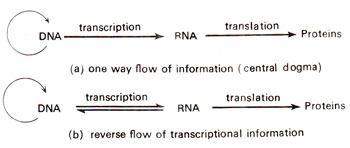Biosynthesis of protein is under direct control of DNA in most cases or else under the control of genetic RNA where DNA is absent. Information for structure of a polypeptide is stored in a polynucleotide chain. Sequences of bases in a particular segment of a polynucleotide chain will determine the sequence of amino acids in a particular polypeptide. The relationship popularly known as
central dogma (Fig. 32.1) explains how protein synthesis is controlled by nucleic acids. DNA, while undergoing self replication, also controls synthesis of specific proteins. Flow of information is one way i.e. from DNA, information is transferred to RNA (mRNA) and from RNA to protein. Evidence is also available where RNA can control synthesis of DNA.

Fig. 32.1. Two versions of the flow of genetic information.
Such RNA was though initially found to be genetic RNA but non-genetic RNA synthesized under control of DNA may also give rise to DNA by reverse process [Fig. 32.1 (b)]. This phenomenon is utilized for the origin of pseudogenes in mammals (see
Organization of Genetic Material 3. Split Genes, Overlapping Genes and Pseudogenes). There is, however, no evidence whatsoever for the synthesis of RNA from protein. If this is proved, one would have to believe in Lamarckism because, if information from proteins can be transferred to RNA and then eventually to DNA, it would mean that information about any acquired character would be possibly transmitted to DNA, the genetic material. This would result in inheritance of acquired characters.

Fig. 32.1. Two versions of the flow of genetic information.
The synthesis of DNA on RNA template in tumour viruses was demonstrated in 1970, simultaneously by two American scientists
H. Temin and
D. Baltimore (consult
Chemistry of the Gene 2. Synthesis, Modification and Repair of DNA). This discovery was considered significant for the understanding of cancer. Therefore, these two American scientists, along with
R. Dulbecco, another American scientist, who worked in London, shared the Nobel Prize in medicine for 1975.
In
Chemistry of the Gene 1. Nucleic Acids and Their Structure, three kinds of non-genetic RNAs were listed. These are (i) mRNA (messenger RNA), (ii) tRNA (transfer RNA), and (iii) rRNA (ribosomal RNA). All these three kinds of RNAs take an active part in protein synthesis. While mRNA and tRNA directly take part in protein synthesis, rRNA does so by making part of structures called ribosomes. The manners in which mRNA and tRNA take part in protein synthesis are now well defined, but the role of rRNA is not fully understood. However, it is definitely known that, while mRNA and tRNA have some kind of specificity, rRNA has a general function to perform. Besides other roles, perhaps it helps in mRNA binding by complementary base pairing, as recently shown in some eukaryotes.
Two major steps are involved in protein synthesis : (i)
transcription, involving transfer of genetic information from DNA to mRNA, and (ii)
translation, involving translation of the language of nucleic acids into that of proteins. Transcription will be discussed in some detail in this section both in prokaryotes and eukaryotes. RNA processing will be discussed in
Expression of Gene : Protein Synthesis 3. RNA Processing (RNA Splicing, RNA Editing and Ribozymes) and translation will be discussed in
Expression of Gene : Protein Synthesis 4. Translation in Prokaryotes and Eukaryotes.





